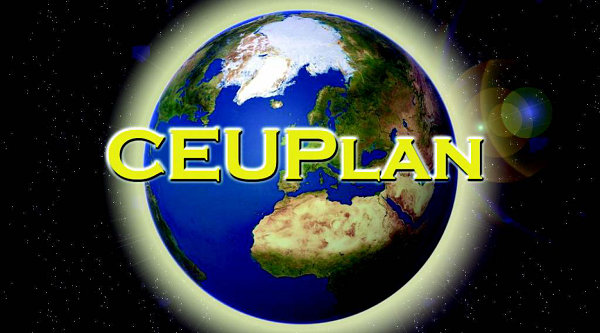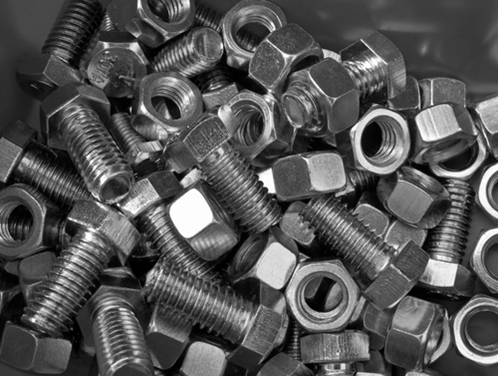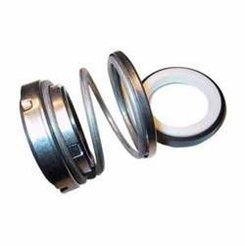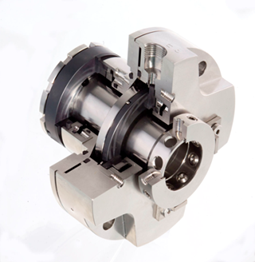 |
|
A special Tribute to all Vietnam Vets, who have given years of service to the water and wastewater treatment industry. Since the 1970s, this group of guys and gals has built the solid foundation of our infrastructures and the effluent quality which we enjoy today!
|
 |
|
Getting Married?
… Wastewater Plant taking Reservations
|
|
Yes, this is right!
Brightwater Treatment Plant – King County, Washington, near Seattle is taking reservations. According to the Educational Director, Susan Tallarico, she has a couple of reservations for the fall of this year. The Brightwater Wastewater Treatment Plant is an unique facility capable of treating 36 MGD and a peak during rainy season of 130 MGD. The facility is located on 114 acres in Woodinville, Washington, which includes the treatment plant, wetlands, open space, and an Environmental Education and Community Center. Susan says that they are about to "test the waters" of conducting marriages at the facility, as a local news reporter came out and did a special TV series of the new treatment plant that opened in 2012. The word got out about their community center and its beautiful location. Don't worry, the wastewater plant is enclosed, so odors are not a problem; however, I asked if anyone had made request for their wedding vows to be read in front of the bar screen. Susan assured me that some "die-hearted wastewater operators" had asked about different areas, with the testimonials forthcoming this fall.
What a great location to tie the knot for a couple of wastewater love birds … for information about the wedding packages, go to the King County's (Washington state) Brightwater Center webpage.
During my interview with Susan related to the Associated Press News Release, she stated that she’s heard from people all over the world inquiring about their wedding packages at the wastewater plant. The other interesting point was how everything has come together over the past twenty years…. Educators from the local school working with the community to involve and inform them about wastewater treatment and where the water goes. In fact, due to the local school teachers' involvement within the community, King County has a very strong water reuse program underway with hopes to totally reuse their plant effluents. The local school teachers are involved with Susan in a pilot program for high school students to undertake a Job Shadowing program starting in the Fall of 2014. Job Shadowing is a process allowing students to watch operators perform their job around a treatment plant and become aware of the various tasks and "Hats" that an operator wears on a daily basis. Ms. Tallarico feels the pilot program will expand into an apprenticeship program, whereby the students will work in the facilities and get paid. This teacher initiative has grown to include curriculum in the public school system to outreach with community leaders and has established a positive outlook on the wastewater treatment program and effluent outfall in the Seattle area. Last year, over 14,000 individuals toured the state-of-the-art facility, and projections for increased attendance are expected this year.
|
 |
|
Pam Restovic, plant operator at the Brightwater facility has been involved with King County for over 28 years, operating wastewater treatment plants. She is very proud of her new facility and the SCADA system for automated controls. As Pam explains, when students and visitor come and see our Control Center and see how effectively our computerized facility operates; they are amazed at the effluent quality that we produce and its discharge into the pristine waterways of Puget Sound. Brightwater is one of four wastewater treatment plants servicing the Seattle area and has plans to expand this facility in the future.
|
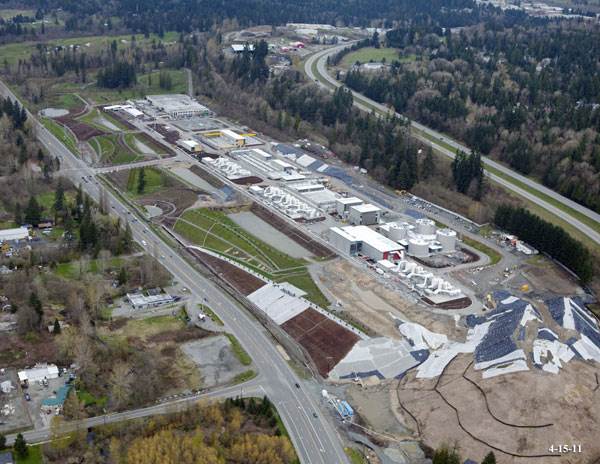
Brightwater Treatment Plant – King County, Washington, near Seattle
|
|
"Nuts, Bolts & Gaskets" is a two-part series on fasteners used in the water - wastewater treatment industry. Rich Varella is the Vice President for TRIPAC Industries. He was involved as purchasing manager for an oil refinery for 17 years before coming to the water and wastewater field in 2000, gaining a great knowledge in heavy duty and commercial usage of fasteners and gaskets. Rich is incredibly knowledgeable about fasteners, their materials of construction and applications, along with being tapped as an expert witness in the industry. He frequently makes presentations at conferences and seminars. CEU Plan is pleased to make "Nuts, Bolts & Gaskets" available to water and wastewater operators for license renewal CEUs.
This course illustrates the NSF-61 requirements for gaskets effective January 2014. Some of the latest ASTM specifications for nut and bolts, along with compatibility to various materials of construction and applications will be discussed. Corrosion and its importance in fasteners around the treatment plant and piping systems are included. This course is One-of-Kind discussing thread lengths and connections, diameter of bolts, and many fundamental aspects of bolts and nuts.
This course is great for any entry level, as well as, a refresher for anyone involved in mechanics, maintenance, or pipe line support staff. We recommend this course for ALL purchasing departments of water and wastewater treatment divisions, as to appreciate and better understand the need for quality fasteners in the shop and around-the-treatment plant.
|

This course will introduce you to the vast topic of Water Loss Control include why controlling water loss is such an important focus for all water utilities. The course will provide detailed references to the different type of losses, real and apparent, that utilities should be closely monitoring as part of their daily operations. The information contained in the course will give the student a better understanding of how to formulate a plan to reduce water loss and provide information on leak detection programs and equipment. Likewise, the course provides information about Water Audits and how the data generated from audits can be helpful in capital and financial planning, how the audits are related to water loss control.
|
 |
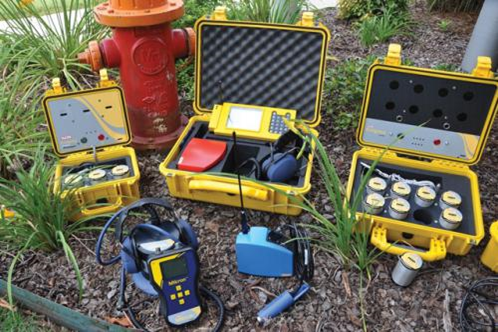 |
By the end of this training course, you will have the ability to:
- Describe facts and statists related to the need for a water loss control program
- Explain the term and importance of unaccountable for water
- Explain that Water Loss Control is a benefit to water providers
- Explain why water utilities should conduct Leak Detection
- Describe and discuss different types of acoustic and non-acoustic leak detection equipment
- Describe and discuss the types of apparent losses
- Describe the methodology of water audits
- Define a Water Balance Table
- Define the data need to conduct a water audit
- Define and explain key Performance Indicators of a completed water audit
- Discuss interpreting and understanding the results of a water audit
|
|
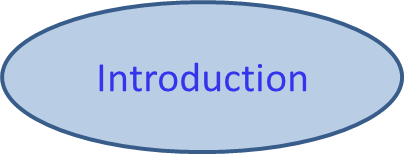 |
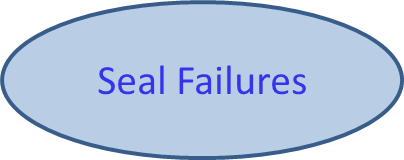 |
This course is designed to give the student a reasonably understanding of what Mechanical Seals are, what makes them function along with some of the issues/problems/concerns associated with them. It explains the features and benefits of using a Mechanical Seal vs. Packing. The course explains the lapping process and why it is necessary to maintain face flatness. It shows and explains how and why a Mechanical Seal functions and why the Seal Interface is important to the life of a seal and why it is important to keep the seals cool, clean and lubricated. The course gives a brief discussion about the Balance Ratios and how they are calculated for a Balanced and Un-Balanced Seal. The course will explain in detail the various components of a Mechanical Seal and the function of each component. It touches briefly on the various Classifications and Arrangement possibilities of a seal and how they differ. It explains some of the auxiliary equipment used with Mechanical Seals such as "Seal Support Systems" or piping plans. And it touches on a few of the more common failure analysis. Overall, the course is designed to give the student a better understanding concerning Mechanical Seals so they can obtain longer service life and less problems from their Mechanical Seals and thus keep our environment clean and safe from contaminants. This is a two part course: Introduction, followed by Mechanical Seal Failures.
|
By the end of this training course, you will have the ability to:
- describe the differences between packing and mechanical seal applications
- identify and discuss the primary and mating rings of a mechanical seal
- investigate worn components of your drive units
- identify the general causes on abrasive surface of a mechanical seal
|
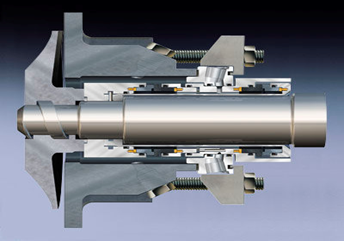 |
|

|
Who should take this training! This training is for public water system operators, waste water operators, plumbers, code officials, fire sprinkler installers, government environmental officials, consumers of water, building or facility owners or any individuals who would like to be educated or have more knowledge of cross-connections control and the hazards that they present.
|
|
Some of the topics covered by the instructor in this first course will be:
|
- Cross-Connection Definitions
- The Essential Factors of a Cross-Connection
- The Causes of Backflow
- Cross-Connection case studies
|
- Why Cross-Connections need to be controlled
- The Resultant Forces
- Why Cross-connections exists
|
|
"Introduction to Cross-connection Control" is the first of a four part cross-connection control training series that is offered by CEU Plan. Instructor James Holeva defines cross-connection, explains why cross-connections need to be controlled, reviews the essential factors of cross-connections, how resultant forces affect cross-connection incidences, what causes backflow, why cross-connections exists, and, by the review of case-studies, how cross-connection incidences can cause harm.
|
 |
By the end of this training course, you will have the ability to:
- explain what is a cross-connection
- identify the impacts that cross-connections have to the public health
- indicate the causes of backflow and why cross-connections exists
- discuss the hazardous resulting from cross-connections
- illustrate the Essential Factors of a Cross-Connection
- describe why Cross-Connections need to be controlled
|
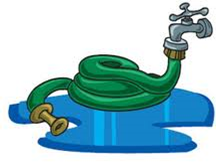 |
|
 |
|
The other courses in this series will detail the various stages of GIS development. These step-by-step will provide procedures and tips in improving your system, as well as, important aspects to consider in engineering your GIS program from the start.
|
|
The GIS course series include:
- GIS Readiness – Performing a Self-Assessment
- Mapping Your System
- Maintaining Your Maps/Geodatabase
- along with this Introduction
|
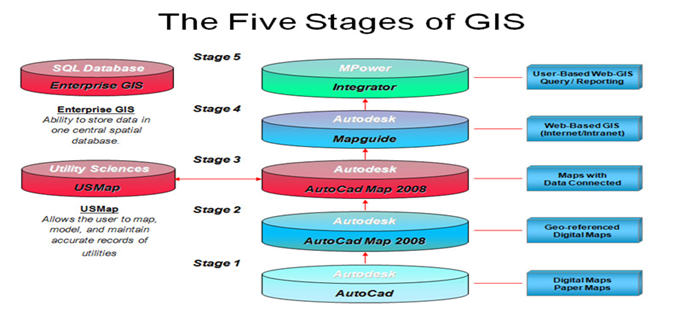 |
|
|
"Introduction to GIS" is the first of a four part series offered by CEU Plan covering Geographic Information Systems. Instructor Jason Brown is an expert of GIS technology and interface. He explains GIS, shows what information is incorporated in GIS, and explains how it benefits its users.
In the third course section, Jason is joined by Ben Glerum, a GIS technician at Ferris State University. They provide some case studies of some GIS systems and illustrates some of the need-to-know criteria related to establishing a digital mapping program.
|
 |
|
|
 |
LABORATORY PRACTICES
-
WASTEWATER MICROBIOLOGY
Toni Glymph-Martin
Margaret Doss
|
 |
|
|
Laboratory Practices:
- Lab Terminology
- Basic Wastewater Lab Procedures
- Basic Drinking Water Quality
- Biochemical Oxygen Demand (BOD)
- Fecal Coliform Bacteria
- Nitrogen-Ammonia
- Drinking Water Techniques
- Basic Chemistry & Laboratory Techniques
|
|
Wastewater Microbiology and Process Control:
- Filamentious Bacteria & Process Control
- Introduction to Basic Microbiology and Process Control
- Wastewater Microbiology and Process Control – part one
- Wastewater Microbiology and Process Control – part two
|
 |
 |
 |
|
|
|
Water Leak Estimator Tools
| Circular Break Around Pipe | Hole In Pipe | Rectangular Break Along Pipe |
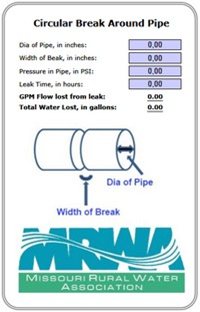 |
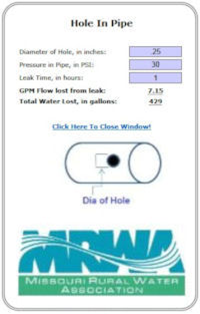 |
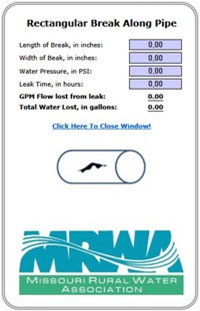 |
|
|
Recently, I was surfin' the web and ran across this unique group of app tools, which any Operator would appreciate. With special permission, we are pleased to re-print this article and provide you with another great resource for your day-to-day operations.
|
|
Web-based Tools Aid Water and Wastewater Specialists with Necessary Calculations!
by Jim Enterline
The Missouri Rural Water Association (MRWA) added another tool in its web-based products today: Certification Eligibility Calculator. This tool calculates time earned for actual work and equivalent experience for water and wastewater specialists.
Because of the complexities of determining one's eligibility for certification, these specialists frequently turn to the MRWA for answers. The three certification specialties include water treatment, water distribution, and wastewater treatment; and each has multiple levels of advancement. The tool is accessible on MRWA's website at: http://moruralwater.org/tools.php
Specialists can now easily calculate their own work experience as a preliminary measure in determining whether or not they have fulfilled the minimum requirements for a particular specialty or level of certification. Final assessment of work experience rests with the Missouri Department of Natural Resources, the agency responsible for implementing and enforcing the federal Safe Drinking Water Act in Missouri.
The MRWA is a non-profit organization that serves the needs of these utilities in Missouri. As a service provider, the association aggressively seeks new and innovative ways to serve the diverse needs of utilities.
Other web-based tools offered by the MRWA are water leak estimators for different types of pipe breaks; monthly and annual water loss calculations for un-accounted water usage; drawdown calculator for determining the depth to the water level in a well; and dosage calculators for determining needed amount of chemical for disinfecting wells, pipes, and storage tanks.
Other smart phone apps are currently under development, as the MRWA continues to provide valuable resources for water and wastewater utilities. This selection of phone apps can be viewed at: http://moruralwater.org/what_we_offer.php#Phone%20Apps
These web-based tools allow specialists in the field to perform various calculations at the tip of their fingers. Many of these tools are also available as smart phone apps for Android and iPhone users.
|
|
Disinfection Formula Calculators
| Pipe Disinfection Formula | Tank Disinfection Formula | Well Casing Disinfection Formula |
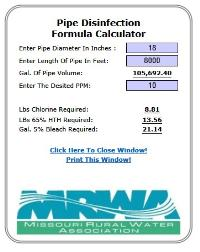 |
 |
 |
this link will take you to their full list of Online Interactive Water Tools:
http://www.moruralwater.org/tools.php
This site and tools – ROCK!
|
|
Tips & Tricks
» Microsoft supports neither the Windows XP operating System nor Internet Explorer 6, 7, or 8 since April of this year. All three of these browsers are very popular with CEU Plan Students. In fact, more than 60% of our students use Internet Explorer to connect with CEU Plan and nearly half of those are using one of these non-supported browsers. The problems associated with these older browsers are two-fold. First, Internet Explorer 6, 7, and 8 do not support html5 at all and even IE9 gives only limited support (IE 6, 7, 8, and 9 score the lowest of ALL versions of ALL browsers in 2014 industry test by Niels Leenheer). This limits the performance of audio/visual content. Secondly, the older browsers leave the computer vulnerable to all sorts of malware. There are a number of browsers available including: Internet Explorer, Firefox, Safari, Opera, and Chrome. At CEU Plan, we test everything with ALL of these browsers before we publish. So, the bottom line is security and performance. We suggest that you keep your browser current.
» The issues with Windows XP are more complex. Many of us use and love Windows XP (it accounts for about 28% of CEU Plan users). We have had it for years and it is familiar. But (and this is a BIG but), it doesn't work nearly as well as newer operating systems. Even something as mundane as USB transfer speeds can see about a ten-fold improvement with a newer OS (supporting USB 3.0 versus 2.0). Since Microsoft doesn't support Windows XP, many coders will not even write programs to work with XP. Finally, security. Even Microsoft is saying that since they no longer issue security updates for XP, there is no protection against new malware. They admit that infection rates for XP-based machines are nearly double that of Windows 7 machines exposed to the same threats. Important considerations.
|
 |
CEU Plan is an ANSI/IACET provider
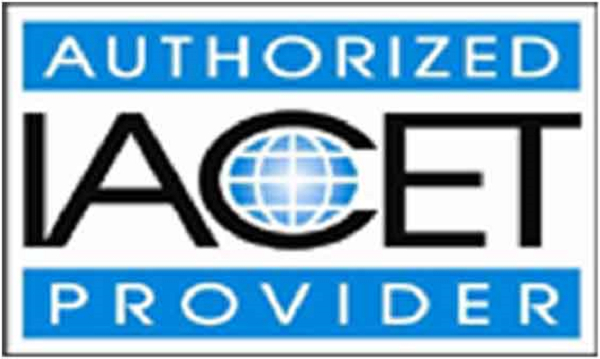

CEU Plan · Post Office Box 10355 · Brooksville, Fl. 34603
|
